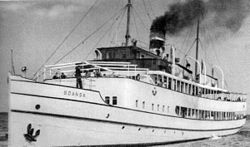Gdańsk (ship, 1927)
|
The Gdańsk in 1934
|
||||||||||||||||||||
|
||||||||||||||||||||
|
||||||||||||||||||||
|
||||||||||||||||||||
|
||||||||||||||||||||
|
||||||||||||||||||||
The Gdańsk was the first Polish passenger ship . It was built in 1927 and used in coastal shipping , as a ferry and as a seaside service ship. In 1939 the German Air Force sank the ship. It was later lifted but probably not repaired and broken up in 1946.
Construction and technical data
At the same time as the new city of Gdynia was being built , tourism on the Polish coast also developed, but in the 1920s only fishing boats, tugs or excursion boats from Gdansk were available for tourists . In order to be able to offer connections along the Polish coast also by Polish ships, the Ministry of Communications ordered two small passenger ships for coastal shipping in 1926 . Even before these ships could be assigned to a shipping company, the Danzig shipyard received the order for what would later become Gdańsk and its sister ship Gdynia in April 1926 . The state-owned shipping company Żegluga Polska, founded in November 1926, was supposed to manage both ships .
In the Gdansk shipyard the ship ran with the hull number 47 on 13 April 1927 by the stack and was named Gdańsk . Her length was 53.70 meters, she was 9.30 meters wide, had a draft of 3.30 meters and was measured at 538 GRT and 234 NRT. The drive consisted of a three-cylinder triple expansion machine that achieved 650 hp and acted on one screw . With that she reached a top speed of 11.0 knots . The crew consisted of 32 officers and men. For trips lasting several days, cabins for up to 120 passengers were available; for shorter trips, the ship was approved for 700 deck passengers.
history
Passenger ship Gdańsk of the White Fleet
After delivery by the shipyard and commissioning on June 19, 1927, Gdynia became the home port of Gdańsk . The Gdańsk was the first passenger ship for the young Polish merchant fleet , followed a short time later by the Gdynia . The shipping company Żegluga Polska used the Gdańsk mainly on the route between Gdynia and the Hel Peninsula . It quickly became apparent that the line could not be operated profitably. In 1928 the Gdańsk took a cruise to Copenhagen and from 1934 the shipping company only used the ship during the holidays. In 1938, the ship hit the headlines when it collided with the Norwegian ship Halversen in front of the port of Gdynia on August 22nd . People were not injured and there was no major damage.
During his operations it turned out that the ship did not meet the expectations in terms of construction. For a passenger ship it was slower than ordered and not agile enough. In addition, the draft of the ship was too great to be able to call at the port of Hel, for example. The ship also took in too much water at sea and was considered very wet.
Tender Gdańsk of the Polish Navy and World War II
Shortly before the start of the Second World War , the Polish Navy took over the ship. As part of the mobilization , the Navy set up two squadrons with auxiliary minesweepers from fishing cutters . On August 28, 1939, she used the Gdańsk and Gdynia as escort ships for the squadron . The ships kept their civilian crew as well as the white paint and remained without armament. Only a few days it was listed as ORP Gdańsk . At the beginning of the German invasion of Poland sunken dive bombers of the type Junkers Ju 87 Group IV. Of Lehrgeschwader 1 the Gdańsk and Gdynia on September 2, 1939 in the Puck Bay before Danzig .
A German rescue team lifted the ship on March 10, 1943 and took it to the Deutsche Werke branch in Gotenhafen for repairs . It is unclear whether repairs were carried out at all. In 1944 a conversion to a cargo ship was planned, but not carried out. During the approach of Soviet troops in March 1945, the Gdańsk was probably still lying as a wreck in Gotenhafen and was sunk again by German troops. In 1946 the ship was scrapped on site.
literature
- Maciej Neumann: Flota II Rzeczypospolitej i jej okręty [The fleet of the Second Republic and its ships] , Wydawnictwo LTW, Łomianki 2013, ISBN 978-83-7565-309-0 .
- Stanisław M. Piaskowski: Okręty Rzeczypospolitej Polskiej 1920–1946 [The Ships of the Republic of Poland 1920–1946] , Planów album, Warsaw 1996, ISBN 83-900217-2-2 .
- Jan Piwowoński: Flota spod biało-czerwonej [Fleet under white and red] , Nasza Księgarnia Publishing House, Warsaw 1989, ISBN 83-10-08902-3 .
- Reinhart Schmelzkopf: Foreign ships in German hands 1939–1945. Strandgut-Verlag, Cuxhaven 2004, DNB 972151001 .
- Jürgen Rohwer , Gerhard Hümmelchen : Chronik des Seekrieges 1939–1945 , edited by the working group for military research and by the library for contemporary history , Manfred Pawlak Verlagsgesellschaft, Herrsching o. J. [1968], ISBN 3-88199-0097 , extended online version .
Web links
- ORP Gdansk at dobroni.pl (Polish), accessed on June 14, 2019
- s / s Gdańsk at graptolite.net , (Polish) accessed on June 14, 2019
Individual evidence
- ↑ Piwowonski, p 56
- ↑ a b ORP Gdansk at dobroni.pl
- ↑ a b s / s Gdańsk at graptolite.net
- ↑ a b melt head, p. 90
- ↑ a b Neumann, p. 242f.
- ↑ a b Piwowonski, p. 57
- ↑ a b Piwowonski, p. 58
- ↑ ORP is the abbreviation for "Okręt Rzeczypospolitej Polskiej" and the name prefix of Polish ships. ORP means "Warship of the Republic of Poland".
- ^ Chronicle of the Naval War: September 2, 1939
- ^ Piaskowski, p. 60
- ↑ Neumann, S. 242f.
- ↑ Piwowonski, pp. 58f.
